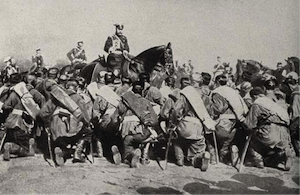

|
War as a Revolutionary Force  The Tsar and His Troops EXTRACT: Orlando Figes, A People's Tragedy: The Russian Revolution, 1891-1924 (Pimlico, 1997), p. 264. The number of NCOs was never enough - the artisan classes who usually made up this tier of the army was generally weak in Russia - and it was unusual after the first year of the war for a front-line regiment of 3,000 men to have more than a dozen officers. Moreover, 60% of the NCOs came from a peasant background, very few had more than a few years' education, and nearly all of them were in their early twenties. The war was this a great democratizer, opening channels of advancement for millions of peasant sons. Their sympathies lay firmly with the ordinary soldiers, and any hopes that they might form a bridge between the high-born officers and their low-born troops were badly misplaced. This was the radical military cohort - literate, upwardly mobile, socially disoriented and brutalized by war - who would lead the mutiny of February, the revolutionary soldiers' committees, and eventually the drive to Soviet power during 1917. Many of the Red Army's best commanders (e.g. Chapaev, Zhukov and Rokossovsky) had been NCOs in the tsarist army, much as the marshals of Napoleon's wars had begun as subalterns in the king's army. The sergeants of the First World War would become the marshals of the Second. |
© 2014 Orlando Figes | All Rights Reserved